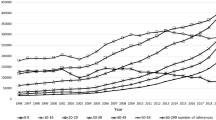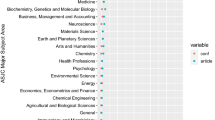Abstract
Large samples of papers published in theJournal of Biological Chemistry in all decades and in some mid-decades werechecked in order to study the referencing pattern, throughout the period 1910–1985, in an internationally leading journal, with especially high “citation impact”. All measures show that there has been a significant growth in the number of references per paper, during most of the period, but mainly from the 1950's on, refuting Meadows' “upper limit”. A detailed comparison to a wide range of fields shows theJBC rates to be among the highest. Eight factors affecting the number of references are discussed, and some projections for the future are made.
Similar content being viewed by others
Notes and references
C.A. Bolles,Characteristics of the Literature of American Studies as Indicated by Bibliographical Citations, Unpublished Ph. D. Dissertation, University of Minnesota, 1975, pp. 57–58.
B. Cronin,The Citation Process, Taylor Graham, London, 1984, pp. 5–24.
O.H. Eisenhardt, Journal of the ASIS vs. Nachrichten für Dokumentation,Nachrichten für Dokumentation, 30 (1979) 81–85.
C.J. Fenichel,Citation Patterns in Information Science, Unpublished Master Thesis, Drexel Institute of Technology, 1969, p.12.
E. Garfield, Citation analysis as a tool in journal evaluationScience, 178 (1972) 471–479.
E. Garfield, Significant journals of science,Nature, 264 (1976) 609–615.
E. Garfield,Essays of an Information Scientists, Vol. 3 (1977–1978), ISI Press, Philadelphia, 1980, pp. 45–51, 132–133, 690–694, 699.
E. Garfield, I.H. Sher, New factors in the evaluation of scientific literature through citation indexing,American Documentation, 14 (1963) 195–201.
E. Garfield et al., Citation data as science indicators, in:Toward a Metric of Science,Y. Elkana et al. (Eds), Wiley, N.Y., 1978, pp. 179–207.
W.O. Hagstrom,The Scientific Community, Basic Books, N.Y., 1965, pp. 128–129.
C.D. Henkle, The periodical literature of biochemistry,Medical Library Association Bulletin, 27 (1938) 139–147.
C.D. Hurt, Methodological citation differences in science technology, and social sciences literature,Library and Information Science Research, 7 (1985) 345–355.
N. Kaplan, The norms of citation behavior: Prolegomena to the footnote,American Documentation, 16 (1965) No. 3, 179–184.
F.C. Kull, Publication trends in microbiology,Bacteriological Reviews, 29 (1965) 534–543.
D. Lindsey,The Scientific Publication System in Social Science, Jossey-Bass, San Francisco and London, 1978, pp. 80–84.
A.J. Meadows, The citation characteristics of astronomical research literature,Journal of Documentation, 23 (1967) 28–33.
A.J. Meadows,Communication in Science, Butterworths, London, 1974, pp. 126–127, 137.
H.W. Menard,Science: Growth and Change, Harvard University Press, Cambridge, Mass., 1971, p. 137.
M.M. Nour, A quantitative analysis of the Research articles published in core literary journals of 1980,Library and Information Science Research, 7 (1985) 261–273.
E.B. Parker, W.J. Paisley, R. Garret,Bibliographic Citations as Unobtrusive Measures of Scientific Communication, Stanford University, Institute for Communication Research, 1967, pp. 26–27, 62.
B.C. Peritz,Research in Library Science as Reflected in the Core Journals of the Profession: a Quantitative Analysis (1950–1975), Unpublished Ph.D Dissertation, University of California, Berkley, 1977, pp. 118–121.
B.C. Peritz, A classification of citation roles for the social sciences and related fields,Scientometrics, 5 (1983) 303–312.
B.C. Peritz, A note on ‘Scholarliness’ and ‘Impact’,Journal of the American Society for Information Science, 34 (1983) 360–362.
D.J. Price, Networks of scientific papers,Science, 149 (1965) 510–515.
D.J. Price, Citation measures of hard science, soft science, technology, and non-science, in:Communication Among Scientists and Engineers,C.E. Nelson,D.K. Pollock (Eds), Heath, Lexington, Mass., 1970, pp. 3–22.
D.J. Price, The citation cycle, American Society for Information Science, 8th Mid-Year Meeting, May 16–19, 1979, Collected Papers (reprinted in:Key Papers in Information Science,B.C. Griffith, (Ed.), Knowledge Industry Publications, White Plains, 1980, 195–210).
I.N. Sengupta, Recent growth of the literature of biochemistry and changes in ranking of periodicals,Journal of Documentation, 29 (1973) 192–211.
E. Shearer, M.J. Moravcsik, Citation patterns in little science and big science,Scientometrics, 1 (1979) 463–474.
E.C. Slater,Biochimica et Biophysica Acta: The Story of a Biochemical Journal, Elsevier, Amsterdam, 1986, pp. 52–54, 66.
L. Smith, Citation analysis,Library Trends, 30 (1981) 83–106.
M. Weinstock, Citation indexes, in:Encyclopedia of Library and Information Science, Vol. 5, Marcel Dekker, N.Y., 1971, pp. 16–40.
H. Wellisch, Journal of the ASIS vs. Nachrichten für Dokumentation: A comparative analysis of citations,Journal of the American Society for Information Science, 31 (1980) 216–218.
D.A. Windsor, Citation of the literature by information scientists in their own publications,Journal of the American Society for Information Science, 24 (1973) 377–381.
D.B. Worthen, Short-lived technical literature: A bibliometric analysis,Methods of Information in Medicine, 17 (1978) 190–198.
L.V. Xhignesse, C.E. Osgood, Bibliographical citation characteristics of the psychological journal network in 1950 and in 1960,American Psychologist, 22 (1967) 778–791.
M. Yitzhaki (Itzchaki),The Structure and Citation Patterns of the International Research Literature of Biblical and Ancient Near-East Studies, Unpublished Ph.D. Dissertation, Rutgers University, 1979, pp. 118–119.
M. Yitzhaki, D. Ben-Tamar, Multiple authorship in biochemistry and other fields; A case study of the Journal of Biological Chemistry throughout 1905–1988,Informetrics 89/90: Second International Conference on Bibliometrics, Scientometrics and Informetrics, London (Ontario), July 5–7, 1989, Elsevier, Amsterdam, 1990, pp. 373–389.
H. Zuckerman, R.K. Merton, Age, aging, and age structure in science, in:A Theory of Age Stratification, Vol.3:Aging and Society,M.W. Riley, et al. (Eds), Russell Sage, N.Y., 1972, pp. 292–356.
Xhignesse andOsgood (note 35) incorrectly conclude that the “density of citation per journal for APA journals is approximately double that for non-APA...due in part to the inclusion among the latter of four psychiatric journals with relatively low densities of referencing”. Our calculations according to their own raw data in Table 2 (p. 782) for 1960 show that: (a) the average number of references per paper for APA journals was thirteen (including two review journals) and ten (excluding them) vs. 10.5 for the non-APA journals. (b) the average for the five psychiatry journals was higher than that for psychology journals: 12.6 vs. 11.4 (or vs. 9.8 if the two review journals are excluded)
The figure given in Table 5 is for papers published in theJournal of the American Society for Information Science (JASIS). A sample of one hundred papers drawn out ofNachrichten für Dokumentation (NfD), the German counterpart ofJASIS, yielded a mean of 19.1 for fifty-five papers with references, but this mean drops down to only 10.5 if the forty-five papers without references are also included in the calculation (Eisenhardt, op. cit. note 3; reported also inWellisch, op. cit., note 32) H. Wellisch, Journal of the ASIS vs. Nachrichten für Dokumentation: A comparative analysis of citations,Journal of the American Society for Information Science, 31 (1980) 216–218.
Author information
Authors and Affiliations
Rights and permissions
About this article
Cite this article
Yitzhaki, M., Ben-Tamar, D. Number of references in biochemistry and other fields; A case study of the Journal of Biological Chemistry throughout 1910–1985. Scientometrics 21, 3–22 (1991). https://doi.org/10.1007/BF02019179
Received:
Issue Date:
DOI: https://doi.org/10.1007/BF02019179




